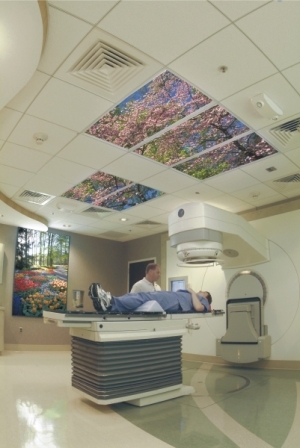by
Amanda Doreson, Project Manager | March 05, 2007

Fischer's artwork can brighten
a patient's experience while
undergoing medical procedures.
Click to enlarge
In 1977,
Joey Fischer's father had a heart attack and was placed in the ICU. His dad would call Fischer and tell him how many holes there were in a specific quadrant of the acoustic tile ceiling. "He must have counted the holes several times a day, ultimately to occupy his time and to keep his mind agile," Fischer reflects.
His father's boredom in the hospital made evident to him that for all the talk about quality patient care, very rarely was patient comfort addressed. A trained artist and photographer, he sought to rectify this problem through the formation of the Art Research Institute, a provider of visual therapy. "Bringing the beach to the patient," his work adorns operating rooms and critical care units in more than 4,300 hospitals throughout the world- from an underground hospital in Turkey to a healthcare facility in Reunion- a small island off the coast of Madagascar.
Fischer markets directly to doctors, whom he meets through exhibitions at trade shows like ASTRO and RSNA. He also works directly with OEMs, who often include his work with the installation of imaging equipment. Fischer recently returned from a show in Dubai, where the response to his work was tremendous. He sees the Middle East as his largest opportunity for growth due the expanding healthcare market in the region.
For Fischer, different types of hospital settings require different motifs. He puts images of spring in cancer wards because it symbolizes a rebirth. "We don't use sunrises or sunsets because they symbolize the end of something, which is contrary to the atmosphere we endeavor to create," he says. He adorns burn wards with tropical scenes since burn victims have low body temperatures. Access to such imagery promotes healing for cancer patients and burn victims alike.
The efficacy of Fischer's visual therapy is supported by scientific findings. In his piece "Effects of Interior Design on Wellness," Dr. Roger Ulrich of Texas A&M University makes the case that the physical environment of a hospital can affect treatment outcomes for patients. Views of nature - like those offered by Fischer's work-- have been shown to mollify patients by reducing blood pressure and heart rate.
The word "hospitality," Fischer reminds us, contains the word hospital. The presence of natural imagery is a sign of caring.
